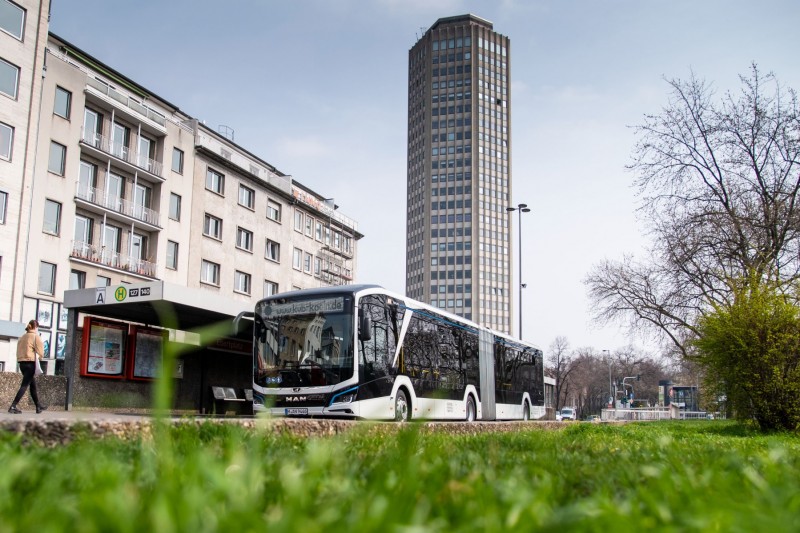Around a hundred thousand diesel buses are still on Europe’s roads with outdated technology. At the same time, the number of e‑buses is rising significantly. It is hardly surprising that electromobility is on the rise. After all, the call for sustainable mobility is getting louder and louder. With the MAN Lion’s City 12 E and the all-electric 18 E articulated bus, MAN Truck & Bus offers the right solution for the urban transport of the future.
Electromobility is electrifying more and more people. This is clearly demonstrated by the rising registration figures for e‑cars. But e‑mobility is not only gaining momentum in private transport. In public transport, too, more and more operators are turning to e‑vehicles, as recent figures from the umbrella organization of European vehicle manufacturers (ACEA) show. Based on bus registration figures, the association reported that sales of electric buses in the European Union increased by 18.4 percent in 2020 compared to 2019. The share of diesel engines, on the other hand, decreased by almost ten percent (source: “ACEA buses by fuel type full-year 2020,” 30 March 2021).
“Overall, the total European market for electric buses was more than 2,000 vehicles last year. And the trend is clearly upward. We expect half of all new city buses to be alternatively powered by 2025.”
- Rudi Kuchta, Head Business Unit Bus
Despite the rising eBus numbers, diesel buses are still by far the most common on EU roads. According to ACEA, there were a total of more than 690,000 buses in 2019, with an average age of 11.7 years — 94.5 percent of which were powered by diesel, and 0.6 percent purely electric (source: ACEA Report “Vehicles in use Europe,” January 2021). “The figures and our experience show that electromobility is on the rise. At the same time, they also make clear what great potential it still holds. Replacing diesel buses with outdated technology with modern electric buses will help enormously to reduce CO2 emissions,” says Kuchta, adding, “This is a key building block in tackling climate change.” After all, with an annual mileage of 50,000 to 60,000 kilometers and a consumption of 36 to 49 liters per 100 kilometers, which varies depending on use, topography and vehicle variant, an eBus traveling with zero local emissions can save around 60 to 80 tons of CO2 per year — compared to a diesel bus and assuming the current electricity mix.
The bus is already considered the most environmentally friendly and economical means of transport. However, local public transport operators and municipalities have it in their own hands to cut CO2 emissions even more and thus contribute to climate protection. The European Union has also recognized this and passed the Clean Vehicle Directive. This provides for binding emission standards in municipal fleets — the legislation has been in force since August 2021. Cities must thus set their course for emission-free mobility. The goal: to move from “low emission” to “no emission.”
“More and more public transport companies have understood this and are relying only on battery-powered city buses for new purchases. Or they are setting clear time targets for converting the entire fleet to zero-emission drives,” says Kuchta. One example is Verkehrsbetriebe Hamburg-Holstein (VHH), which has been procuring only locally emission-free, battery-powered buses since 2020. The goal is to convert the entire bus fleet to zero-emission drives as far as possible by 2030.
In order to provide transport companies with the best possible support on their way to zero-emission mobility, the company offers an overall concept that brings together holistic eMobility consulting and tailored, forward-looking solutions. Because for MAN, too, the future of urban mobility is electric. “We are convinced that electromobility is the key technology for commercial vehicle transport of the future. For this reason, we are constantly driving technologies and progress forward together with our customers,” says Rudi Kuchta. The focus here is on the MAN Lion’s City E — and thus the all-electric solution for public transport.
For months now, the MAN Lion’s City E has been demonstrating in more and more cities throughout Europe how excellently it masters urban traffic and how easily it can be integrated into existing processes. During an MAN eBus test drive that took place in Munich in May of this year, it also cracked the 550-kilometer mark under realistic everyday conditions with just one battery charge. “The issue of range plays an essential role for our customers.
After all, on lines that were previously served by a single vehicle with an internal combustion engine, only one electric vehicle will be on the road in the future. During the MAN Efficiency Run, our eBus impressively demonstrated how suitable electric mobility already is for everyday use,” says Kuchta. Even with a realistic range of “only” 400 kilometers in regular operation, the bus could cover 98 percent of the routes served by MAN customers without intermediate charging. And it would then be charged in the depot — with the advantage that operators would not have to invest in additional charging infrastructure in the city area.

















